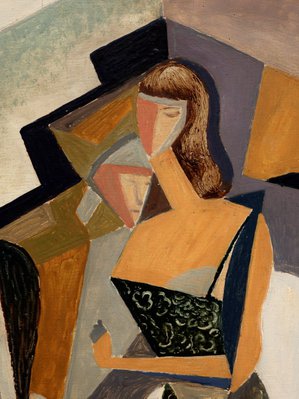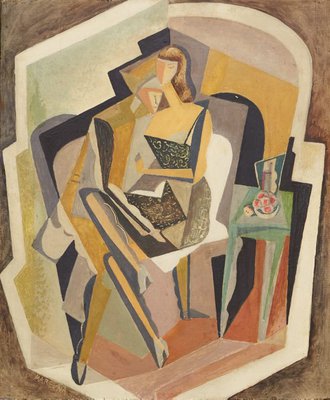Title
Deux personnages assis (Intimité)
circa 1915-circa 1917
Artist




-
Details
- Other Title
- Two people sitting (Intimacy)
- Date
- circa 1915-circa 1917
- Media category
- Painting
- Materials used
- oil enamel on plywood
- Dimensions
- 46.0 x 38.0 cm board
- Signature & date
Signed l.l., scratched into paint "MAREVNA". Not dated.
- Credit
- Purchased 2018 with funds raised from the 2018 and 2019 Art Gallery of New South Wales Foundation gala dinners and the Keith Potten Bequest
- Location
- South Building, ground level, 20th-century galleries
- Accession number
- 579.2018
- Copyright
- © Marie Vorobieff/ADAGP. Copyright Agency
- Artist information
-
Maria Vorobieff-Stebelska (Marevna)
Works in the collection
- Share
-
-
About
Maria Vorobev-Stebleska was born in Cheboksary, Russia and spent her childhood in Tbilisi, capital of Georgia, then under Russian control. She was given the nickname ‘Marevna’, after a mythical Russian sea princess, by Russian writer and activist Maxim Gorky. In the Autumn of 1912, at the age of 20, she moved to Paris as an art student where she initially studied at the Russian Academy in Paris and met other emigre artists including Sergei Bulakovsky, Marie Vasilev, Ossip Zadkine and Chaïm Soutine. Within a few months of her arrival, she forged new friendships with members of the Parisian avant-garde, particularly with the artists associated with “La Ruche” in Montparnasse, and established a studio nearby.
Often cited as the ‘first’ female cubist, there is no question that Marevna is one of only a very small number of female painters – including Maria Blanchard, Alice Bailly, Alicja Halicka, Marie Laurencin, Sonia Delaunay and Suzanne Duchamp – who were active in the Parisian cubist circle prior to and during World War I. Her engagement with cubist principles dates from around the time of the ‘Salon de la Section d’Or’, a large cubist exhibition held at Galerie Boétie in October 1912 which helped to broaden the audience for the movement and to establish it as the leading mode of avant-garde painting at the time. As Apollinaire, chief theorist of cubism, wrote, the idea behind the exhibition was to “present the Cubists, no matter of what tendency … as the most serious and most interesting artists of the epoch.”(1)
The apparent inclusiveness of Apollinaire’s statement might be regarded as an opening for artists on the fringe of cubism to gain wider acceptance. However, as Gill Perry has illuminated in her work on women artists and the Parisian avant-garde, female artists in particular would continue to face obstacles to being recognised for their contribution to the movement and were often overshadowed at the time by the art practices of their male partners.(2)
In 1915 Marevna began a relationship with Mexican artist Diego Rivera which lasted until 1921 and which produced their daughter, Marika. The work of the two artists over this period reveals a strong artistic dialogue and a shared investment in the mathematical principles espoused by the key protagonists of the Section d’Or – particularly Albert Gleizes, André Lhote and Jean Metzinger. Both artists exhibited their works at the Salon d’Automne and Salon des Indépendants but while Rivera’s work became championed by the group, Marevna’s practice was, comparatively speaking, relegated to the periphery.
This work was executed during Marevna’s relationship with Rivera, the time at which she was most closely involved with the Parisian cubist circle, and it demonstrates her rigorous and sophisticated engagement with cubist principles. The painting’s wonderfully precise and harmonious composition depicts the artist (recognisable by her sensuous hair) in an embrace with a French World War I infantryman. It demonstrates the artist’s confident command of mathematical approaches to composition and, moreover, it speaks to her self-assurance in choosing to depict herself in such an intimate pose.
(1) Guillaume Apollinaire, ‘Chroniques d’art’, cited in Douglas Cooper, ‘The Cubist Epoch’, Phaidon, London, 1971, p.105.
(2) Gill Perry, 'Women artists and the Parisian avant-garde', Manchester University Press, Manchester, 1995, p.60. -
Exhibition history
Shown in 3 exhibitions
Retrospective 1910: le salon des indépendants de Paris, Petit Palais, Genève, Genève, 20 May 1969–20 Jun 1969
Marevna, Petit Palais, Genève, Genève, 08 Jan 1971–14 Feb 1971
20th-Century galleries, ground level (rehang), Art Gallery of New South Wales, Sydney, 20 Aug 2022–2023
-
Bibliography
Referenced in 2 publications
-
Petit Palais, Genève, Marevna, Genève, 1971, (illus.).
-
Petit Palais, Genève, Retrospective 1910: le salon des indépendants de Paris, Genève, 1969, (illus.).
-
-
Provenance
Maria Vorobieff-Stebelska (Marevna), circa 1915-1967, London/England, sold in 1967 to Swiss collector Dr Oscar Ghez (1905-1998), for the collection of the Petit Palais, Geneva
Petit Palais, Genève, 1967-1989, Geneva/Switzerland, sold to a Swiss Private collection 1988/89
Private Collection, 1989-2005, Switzerland, Sold to a French Private collection 2004/5
Private Collection, 2005-2018, Paris/France, Purchased by the AGNSW through Cyrille de Gunzburg, Paris 2018
